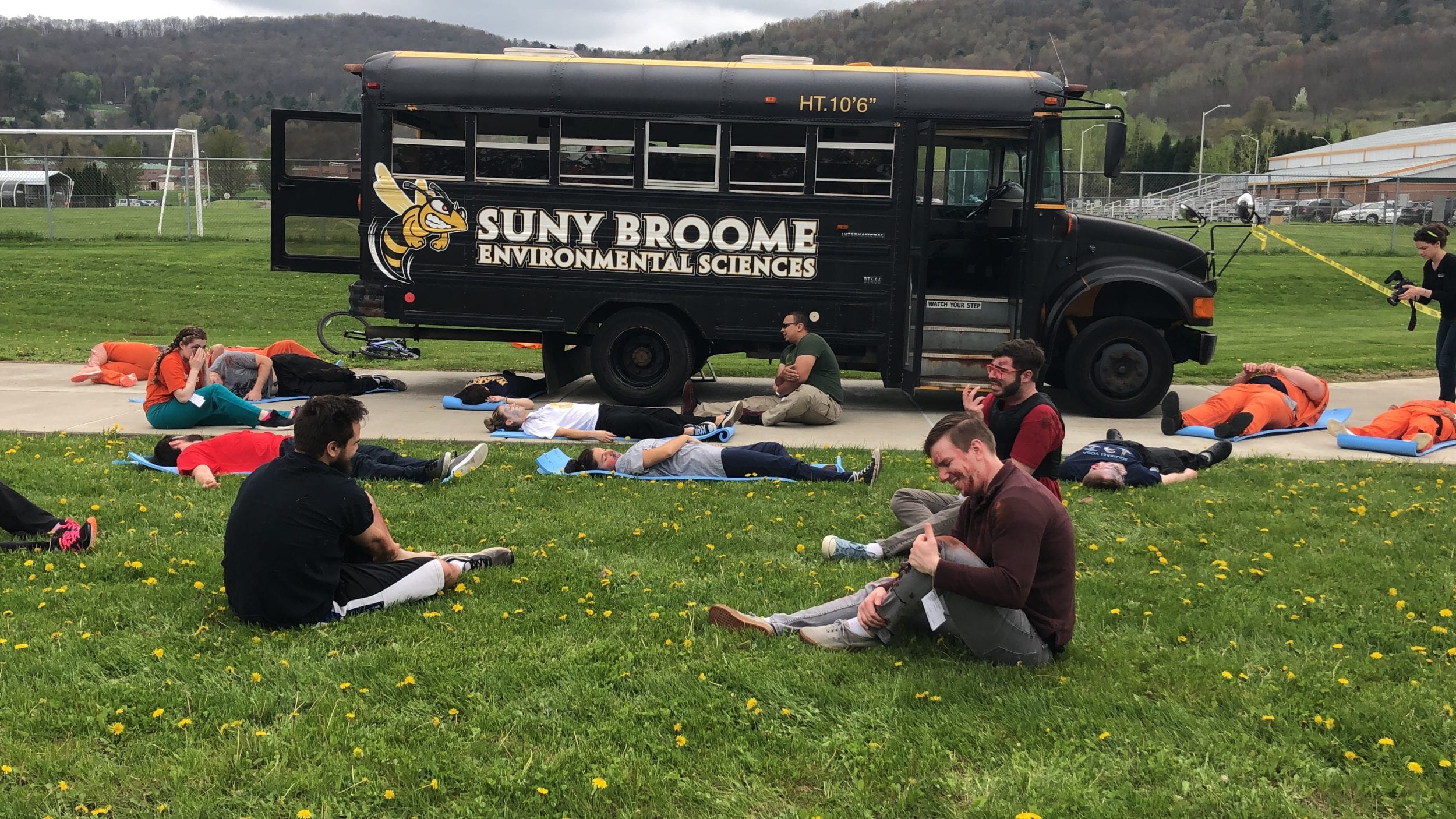As blood soaked their tattered orange uniforms, a bevy of screaming inmates limped out of the bus, under the watchful eye of a corrections officer. Bodies littered the grass – some emitting howls of pain, others ominously still – as a mysterious white powder descended in a cloud, released from the backpack of a slain motorcyclist.
SUNY Broome’s 2019 Mock Environmental Disaster Drill had begun.

The annual event, which brings together different departments across campus, serves as training for first responders, future healthcare providers and more – some in areas you might not expect. Hospitality students cooked up lunch, drawing on mass food production skills used by organizations such as the Red Cross, while budding reporters gathered footage for a nightly newscast.

As the drill unfolded, a crowd of dental hygiene students watched, clustered together in their maroon scrubs. Their role came a little later in the drill.
“We work in the morgue and help identify the victims through their teeth,” explained student Emily Bates.

Medical Assisting students were central to the event, evaluating patients alongside the paramedics and, later, working in the makeshift hospital’s clinic.

Coated in flour, Binghamton Advantage Program student Danyel Christopher lay motionless on the grass, awaiting the arrival of paramedics. The flour substituted for the scenario’s dangerous chemical, scrubbed off – virtually speaking – by the county HazMat team in an inflatable shower.

Danyel learned about the drill in her chemistry class and volunteered for extra credit, she explained. “I have to seem to be in a lot of agony and pain,” she said. “I’ve never been an actor; it’s kind of outside my box. I’m trying out new things.”

Blue-vested Criminal Justice students worked to secure the scene. The drill provides a good opportunity for the campus community to reflect on their own disaster preparedness, while honing skills outside the classroom, reflected Criminal Justice – Corrections major Rachael Klug.

“We are here to learn these techniques. This is great practice,” she said.

First on the scene were paramedic students, who evaluated the extent of patient injuries, set up a triage system and carefully transported their charges to the makeshift hospital in the Decker Health Sciences Building.

“This is a good integration between different departments and programs at the college,” said

Adam Johnson, a first-year student in the Paramedic program, who participated in the drill for the first time. “Teamwork is important, and the interrelationship between the different emergency services.”

Along the way, students in the Health Information Technology program gathered the needed data that follows patients throughout the healthcare labyrinth. White-coated students in the Clinical Laboratory Technician program conducted tests and, later on, Hornets in the Physical Therapist Assistant program helped the wounded regain their full mobility.

Patients were evaluated in the staged emergency room, with nursing students conducting a variety of life-saving maneuvers at the direction of the scene’s physicians – their professors. In the hallway, nursing and radiologic technology students conducted the delicate transfer of a non-responsive patient from a large bed to a gurney, which was then wheeled into the X-ray room.

By including shackled prisoners in the drill, future healthcare providers were tested both on the procedures they learned in the classroom – and on their mission to provide compassionate care, no matter the identity of the patient.

“Every experience is going to be a little different. Generally, when you’re dealing with patients who are incarcerated, you often have an officer with you in the room. The exam is usually the same, as long as they’re compliant. If there not, you might have to use other measures,” explained Trisha Illsley, a second-year Rad Tech student. “There is a lot of critical thinking that goes into this.”


